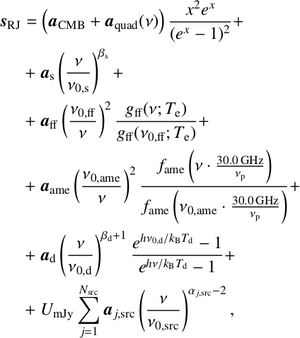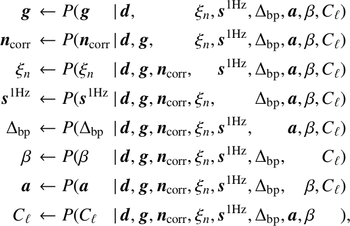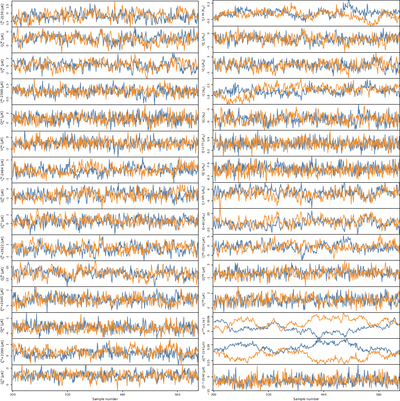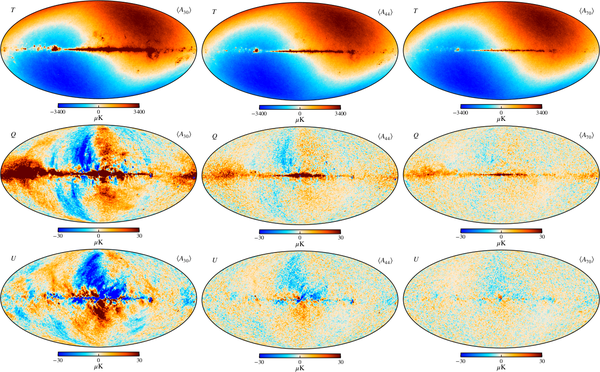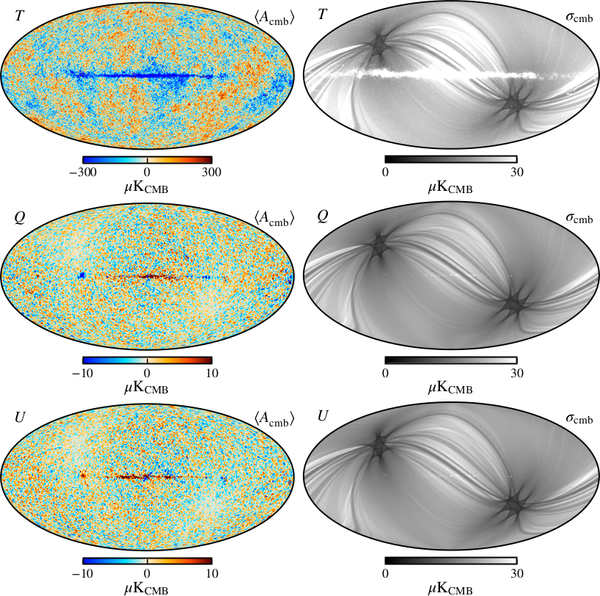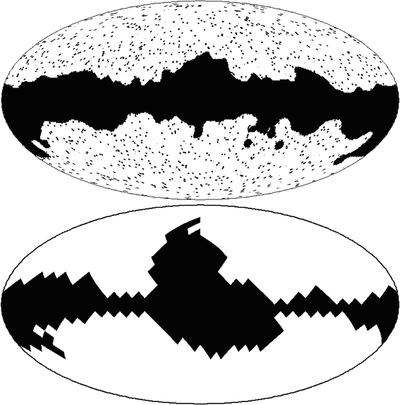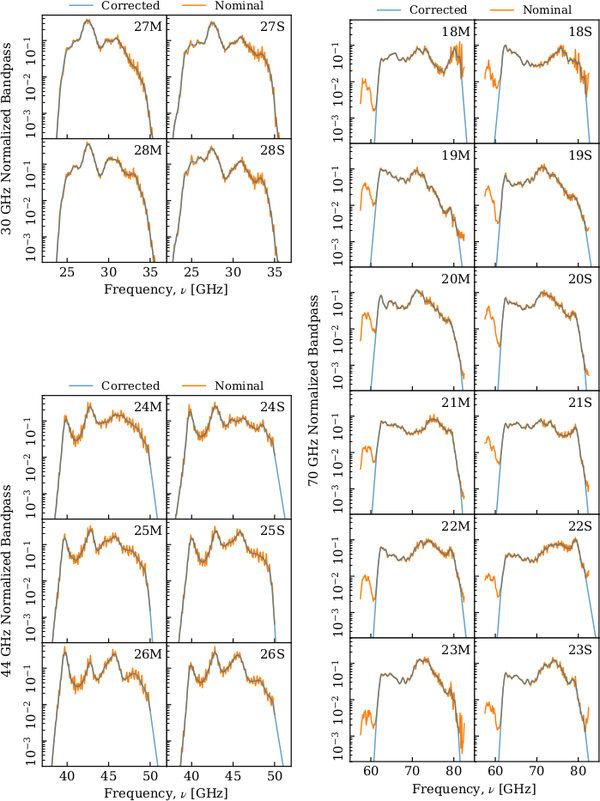BeyondPLANCK
BeyondPlanck[edit]
Overview and background[edit]
As of 2020 and into the foreseeable future, ESA's Planck satellite measurements represent the state-of-art in terms of full-sky observations of the microwave sky between 30 and 857GHz, and the work by the Planck collaboration in terms of processing and interpreting these observations are summarized in a series of 150 papers. Despite these massive efforts, several known outstanding issues regarding the final Planck maps remained unresolved at the end of the funded analysis phase, and several external initiatives were started to address these. One of these was BeyondPlanck, which aimed to re-process the Planck LFI data within a self-consistent end-to-end Bayesian framework, in which both instrumental and astrophysical parameters are fitted jointly. This work started in 2018, and was successfully concluded in 2022. The final results from this project are described in a series of 17 papers, and the products made available through the Planck Legacy Archive. A long-term goal is to apply these techniques to a wide range of state-of-the-art experiments, and this work is organized within the Cosmoglobe project.
Data model[edit]
The main novel feature of the BeyondPlanck processing is a single joint parametric data model that accounts for both astrophysical and instrumental parameters on the form:
where
- t denotes time sample and j denotes LFI radiometer index
- g denotes the instrumental gain
- P is the pointing matrix
- M denotes the component-frequency mixing matrix, which depends on both astrophysical foreground spectral parameters, beta, and the instrument bandpass
- a^c denotes the spatial amplitude map of component c
- B denotes beam convolution (either with the symmetric main beam response, the asymmetric far-sidelobe beam response, or full 4pi response)
- s^orb denotes the orbital CMB dipole
- s^fsl denotes the sky signal observed through the far sidelobes
- s^1Hz denotes electronic 1Hz spike contamination
- n^corr denotes instrumental correlated noise
- n^w denotes instrumental white noise
Explicitly, the sum over components reads as follows (neglecting for notational simplicity bandpass integration; this is accounted for in the actual processing)
In addition to these explicit parameters, the model also includes hyper-parameters for some of the stochastic fields, perhaps most notably the CMB power spectrum, C_l, which describes the variance of the CMB field, and the correlated noise power spectral density, N_corr(f), as a function of temporal frequency.
For further information regarding this data model, see BeyondPlanck overview paper and references therein.
Data sets[edit]
The above data model is fitted using the following combination of datasets:
- Planck LFI time-ordered data for 30, 44 and 70 GHz
- 9-year WMAP frequency maps at Ka-band (33 GHz), Q-band (41 GHz), and V-band (61 GHz). The temperature component is sampled at full angular resolution with a white noise model, while polarization is sampled at low resolution with a dense covariance matrix
- Planck PR4 HFI 353 GHz in polarization
- Planck PR4 HFI 857 GHz in temperature
- Haslam 408 MHz, reprocessed by Remazeilles et al. (2014)
Posterior distribution and Gibbs sampling[edit]
Let omega be the set of all free parameters in the above data model. The BeyondPlanck data model is then fitted to the listed data sets by mapping out the full joint posterior distribution by Monte Carlo sampling,
where the likelihood is defined by the white noise distribution
The prior, P(omega), is summarized in the BeyondPlanck overview paper, and consists of a mixture of informative and algorithmic priors.
In practice, the posterior mapping is performed using Gibbs sampling with the following Gibbs chain,
Four independent chains are run for each 1000 iterations, and the first 200 samples are excluded as burn-in, leaving a total of 3200 samples for final analysis. All products listed below are derived from those post-burn-in 3200 samples.
Products[edit]
The BeyondPlanck products are available both through the Planck Legacy Archive and through the Cosmoglobe homepage.
Markov Chain files[edit]
The full Markov Chains are provided on an HDF5 format, which have convenient IO wrappers for most commonly used programming languages (Python, C/C++, Fortran etc.). Three types of chain files are provided, corresponding to 1) full chains; 2) resampled CMB temperature chains; and 3) resampled CMB polarization chains. Each chain file stores each complete sample in a separate HDF dataset ("folder") marked "NNNNNN" (e.g., "000010" for sample number 10). The internal structure of each sample folder is summarized below for each chain file type. (Only main variables are listed below.)
Full chains[edit]
| Description | Markov chains from main run that includes both astrophysical and instrumental parameters. |
| Filename | BP_c000{1,2,3,4}_v2.h5 |
| Number of samples per chain | 1000 |
| Size per chain file | 1.7 TB |
| HDF path | Description | Specification | Notes |
|---|---|---|---|
| ame/amp_alm | (Unconvolved) a_lm's of AME component map (T-only) | uK_RJ at 22 GHz | Ordered according to libsharp convention |
| ame/nu_p_map | AME nu_peak sky map | GHz in flux density units | See Andersen et al. (2022) for details |
| cmb/amp_alm | (Unconvolved) a_lm's of CMB component map (T,Q,U) | uK_cmb | Ordered according to libsharp convention |
| cmb/sigma_l | Angular power spectrum of CMB component map, sigma_l | uK_cmb^2 | Ordered as {TT,TE,TB,EE,EB,BB} |
| dust/amp_alm | (Unconvolved) a_lm's of dust component map (T,Q,U) | uK_RJ at 857 GHz for T; at 353 GHz for Q,U | Ordered according to libsharp convention |
| dust/beta_map | Thermal dust spectral index, beta_d, map (T,Q,U) | Unitless | Spatially constant but variable |
| dust/T_map | Thermal dust temperature, T_d, map (T,Q,U) | Kelvin | Fixed to Planck PR4; does not vary with sample |
| ff/amp_alm | (Unconvolved) a_lm's of free-free component map (T-only) | uK_RJ at 40 GHz | Ordered according to libsharp convention |
| md/{channel label} | 4-element array with {monopole, d_x, d_y, d_z} corrections | Same units as respective frequency channel | Only monopoles and Haslam dipoles are non-zero |
| radio/amp | Radio source amplitude per object (T-only) | mJy at 30 GHz | Ordered according to BP/Planck Commander point source catalog |
| radio/spec_ind | Radio source spectral index per object (T-only) | Unitless | |
| synch/amp_alm | (Unconvolved) a_lm's of synchrotron component map (T,Q,U) | uK_RJ at 408 MHz in T; at 30 GHz in Q,U | Ordered according to libsharp convention |
| synch/beta_map | Synchrotron spectral index, beta_s, sky map | Unitless | See Svalheim et al. (2022) for details |
| tod/{channel label}/1Hz_ampl | 1Hz amplitude per radiometer and PID | Volt | |
| tod/{channel label}/1Hz_temp | Binned 1Hz template per radiometer | Unitless | Binned between 0 and 1 sec |
| tod/{channel label}/accept | Accept flag per radiometer and PID | Unitless | 0 = rejected, 1 = accepted |
| tod/{channel label}/chisq | Reduced normalized chisq per radiometer and scan | sigma | See Ihle et al. (2022) for details |
| tod/{channel label}/gain | Total gain per radiometer and scan | V/K | See Gjerløw et al. (2022) for details |
| tod/{channel label}/map | Frequency map for given channel (T,Q,U) | uK_cmb | See Basyrov et al. (2022) for details |
| tod/{channel label}/rms | Frequency standard devivation map for given channel (T,Q,U) | uK_cmb | See Basyrov et al. (2022) for details |
| tod/{channel label}/xi_n | Noise power spectral density parameters for radiometer and PID | {sigma_0, alpha, fknee, A_s} | See Ihle et al. (2022) for details |
Resampled CMB temperature chains[edit]
| Description | Markov chains from CMB temperature analysis. These are produced by imposing a CMB confidence mask on the CMB component, while fixing instrumental and (most of the) astrophysical parameters at the values sampled in the main run. Each CMB temperature sample in these chain represents one in-painted Gaussian constrained realization with full-sky coverage. These samples are useful for CMB temperature analysis. See Colombo et al. (2022) and Paradiso et al. (2022) for details. |
| Filename | BP_c000{1,2,3,4}_Tresamp_v2.h5 |
| Number of samples per chain | 1000 |
| Size per chain file | 15 GB |
| HDF path | Description | Specification | Notes |
|---|---|---|---|
| cmb/amp_alm | (Unconvolved) a_lm's of CMB component map (T,Q,U) | uK_cmb | Ordered according to libsharp convention |
| cmb/sigma_l | Angular power spectrum of CMB component map, sigma_l | uK_cmb^2 | Ordered as {TT,TE,TB,EE,EB,BB} |
| cmb/D_l | Ensemble averaged (theory) angular power spectrum of CMB component map, D_l | uK_cmb^2 | Ordered as {TT,TE,TB,EE,EB,BB} |
Resampled CMB polarization chains[edit]
| Description | Markov chains from CMB polarization analysis. These are produced by resampling the CMB a_lms for l <= 64, while fixing instrumental and (most of the) astrophysical parameters at the values sampled in the main run. These samples are useful for low-resolution CMB polarization analysis. See Colombo et al. (2022) and Paradiso et al. (2022) for details. |
| Filename | BP_c000{1,2,3,4}_Presamp_v2.h5 |
| Number of samples per chain | 50.000 |
| Size per chain file | 2.3 GB |
| HDF path | Description | Specification | Notes |
|---|---|---|---|
| cmb_lowl/amp_alm | (Unconvolved) a_lm's of CMB component map (T,Q,U), lmax = 64 | uK_cmb | Ordered according to libsharp convention |
Frequency maps[edit]
The BeyondPlanck frequency FITS maps are produced by averaging individual frequency map samples over Gibbs iterations, and thus correspond to posterior mean maps. We note that error propagation with these maps is challenging, and these are primarily provided for visualization and comparison purposes. For precision scientific analysis, operating with the individual samples provided in the chain files is highly encouraged to propagate errors properly.
Note 1: Unlike Planck DR3, but similar to Planck PR4, the BeyondPlanck frequency maps retain the CMB Solar dipole. Note 2: Unlike Planck, but similar to WMAP, the BeyondPlanck frequency maps retain the relativistic kinematic quadrupole. Instead of subtracting this signal, it is included as an additional component in the signal model.
| Filename = BP_{FREQ}_IQU_n{NSIDE}_v2.fits | |||
|---|---|---|---|
| EXTNAME = 'FREQ-MAP' : Data columns | |||
| Column Name | Data Type | Units | Description |
| I_MEAN | Real*4 | uK_cmb | The signal intensity map |
| Q_MEAN | Real*4 | uK_cmb | The signal Stokes Q map |
| U_MEAN | Real*4 | uK_cmb | The signal Stokes U map |
| I_RMS | Real*4 | uK_cmb | The signal intensity white noise RMS |
| Q_RMS | Real*4 | uK_cmb | The signal Stokes Q white noise RMS |
| U_RMS | Real*4 | uK_cmb | The signal Stokes U white noise RMS |
| I_STDDEV | Real*4 | uK_cmb | The signal intensity posterior std (~ systematic uncertainty) |
| Q_STDDEV | Real*4 | uK_cmb | The signal Stokes Q posterior std (~ systematic uncertainty) |
| U_STDDEV | Real*4 | uK_cmb | The signal Stokes U posterior std (~ systematic uncertainty) |
| Keyword | Data Type | Value | Description |
| PIXTYPE | string | HEALPIX | |
| COORDSYS | string | GALACTIC | Coordinate system |
| ORDERING | string | RING | Healpix ordering |
| NSIDE | Int | 512 or 1024 | Healpix Nside |
| FIRSTPIX | Int*4 | 0 | First pixel number |
| LASTPIX | Int*4 | 3145727 or 12582911 | Last pixel number |
| FREQ | string | nnn | The frequency channel |
Component maps[edit]
| Filename = BP_cmb_IQU_n1024_v2.fits | |||
|---|---|---|---|
| EXTNAME = 'FREQ-MAP' : Data columns | |||
| Column Name | Data Type | Units | Description |
| I_MEAN | Real*4 | uK_cmb | The CMB intensity map |
| Q_MEAN | Real*4 | uK_cmb | The CMB Stokes Q map |
| U_MEAN | Real*4 | uK_cmb | The CMB Stokes U map |
| I_STDDEV | Real*4 | uK_cmb | The CMB intensity posterior std |
| Q_STDDEV | Real*4 | uK_cmb | The CMB Stokes Q posterior std |
| U_STDDEV | Real*4 | uK_cmb | The CMB Stokes U posterior std |
| Keyword | Data Type | Value | Description |
| COORDSYS | string | GALACTIC | Coordinate system |
| ORDERING | string | RING | Healpix ordering |
| NSIDE | Int | 1024 | Healpix Nside |
| Filename = BP_CMB_QU_map_n8_v2.fits | |||
|---|---|---|---|
| EXTNAME = 'FREQ-MAP' : Data columns | |||
| Column Name | Data Type | Units | Description |
| TEMPERATURE | Real*4 | uK_cmb | Low-resolution CMB intensity map |
| Q-POLARIZATION | Real*4 | uK_cmb | Low-resolution CMB Stokes Q map |
| U-POLARIATION | Real*4 | uK_cmb | Low-resolution CMB Stokes U map |
| Keyword | Data Type | Value | Description |
| COORDSYS | string | GALACTIC | Coordinate system |
| ORDERING | string | RING | Healpix ordering |
| NSIDE | Int | 8 | Healpix Nside |
| Filename = BP_cmb_resamp_I_n1024_v2.fits | |||
|---|---|---|---|
| EXTNAME = 'FREQ-MAP' : Data columns | |||
| Column Name | Data Type | Units | Description |
| I_Stokes | Real*4 | uK_cmb | The CMB intensity map |
| Keyword | Data Type | Value | Description |
| COORDSYS | string | GALACTIC | Coordinate system |
| ORDERING | string | RING | Healpix ordering |
| NSIDE | Int | 1024 | Healpix Nside |
| Filename = BP_ame_I_n1024_v2.fits | |||
|---|---|---|---|
| EXTNAME = 'FREQ-MAP' : Data columns | |||
| Column Name | Data Type | Units | Description |
| I_MEAN | Real*4 | uK_RJ | The AME intensity map |
| I_NU_P_MEAN | Real*4 | GHz | AME nu_peak frequency mean |
| I_STDDEV | Real*4 | uK_RJ | AME intensity posterior std |
| I_NU_P_STDDEV | Real*4 | GHz | AME nu_peak frequency rms |
| Keyword | Data Type | Value | Description |
| COORDSYS | string | GALACTIC | Coordinate system |
| ORDERING | string | RING | Healpix ordering |
| NSIDE | Int | 1024 | Healpix Nside |
| FWHM | Real*4 | 120 | Smoothing FWHM in arcmin |
| NU_REF_T | Real*4 | 22.0 | AME reference frequency in GHz |
| Filename = BP_dust_IQU_n1024_v2.fits | |||
|---|---|---|---|
| EXTNAME = 'FREQ-MAP' : Data columns | |||
| Column Name | Data Type | Units | Description |
| I_MEAN | Real*4 | uK_RJ | Posterior mean intensity map |
| Q_MEAN | Real*4 | uK_RJ | Posterior mean Stokes Q map |
| U_MEAN | Real*4 | uK_RJ | Posterior mean Stokes U map |
| P_MEAN | Real*4 | uK_RJ | Posterior mean polarization amplitude, P = sqrt(Q^2 + U^2) |
| I_BETA_MEAN | Real*4 | Unitless | Posterior mean spectral index, beta_d, in intensity |
| QU_BETA_MEAN | Real*4 | Unitless | Posterior mean spectral index, beta_d, in polarization |
| I_T_MEAN | Real*4 | Kelvin | Posterior mean dust temperature, T_d, in intensity |
| QU_T_MEAN | Real*4 | Kelvin | Posterior mean dust temperature, T_d, in polarization |
| I_STDDEV | Real*4 | uK_RJ | Posterior rms intensity map |
| Q_STDDEV | Real*4 | uK_RJ | Posterior rms Stokes Q map |
| U_STDDEV | Real*4 | uK_RJ | Posterior rms Stokes U map |
| P_STDDEV | Real*4 | uK_RJ | Posterior mean polarization amplitude, P = sqrt(Q^2 + U^2) |
| I_BETA_STDDEV | Real*4 | Unitless | Posterior rms spectral index, beta_d, in intensity |
| QU_BETA_STDDEV | Real*4 | Unitless | Posterior rms spectral index, beta_d, in polarization |
| I_T_STDDEV | Real*4 | Kelvin | Posterior mean rms temperature, T_d, in intensity |
| QU_T_STDDEV | Real*4 | Kelvin | Posterior mean rms temperature, T_d, in polarization |
| Keyword | Data Type | Value | Description |
| COORDSYS | string | GALACTIC | Coordinate system |
| ORDERING | string | RING | Healpix ordering |
| NSIDE | Int | 1024 | Healpix Nside |
| FWHM | Real*4 | 10 | Smoothing FWHM in arcmin |
| NU_REF_T | Real*4 | 545 | Reference frequency in temperature in GHz |
| NU_REF_P | Real*4 | 353 | Reference frequency in polarization in GHz |
| Filename = BP_freefree_I_n1024_v2.fits | |||
|---|---|---|---|
| EXTNAME = 'FREQ-MAP' : Data columns | |||
| Column Name | Data Type | Units | Description |
| I_MEAN | Real*4 | uK_RJ | Posterior mean intensity map |
| I_TE_MEAN | Real*4 | Kelvin | Posterior mean electron temperature, T_e. (Fixed in current analysis) |
| I_STDDEV | Real*4 | uK_RJ | Posterior rms intensity map |
| I_TE_STDDEV | Real*4 | Kelvin | Posterior rms electron temperature, T_e. (Zero i in current analysis) |
| Keyword | Data Type | Value | Description |
| COORDSYS | string | GALACTIC | Coordinate system |
| ORDERING | string | RING | Healpix ordering |
| NSIDE | Int | 1024 | Healpix Nside |
| FWHM | Real*4 | 30 | Smoothing FWHM in arcmin |
| NU_REF_T | Real*4 | 40.0 | Reference frequency in temperature in GHz |
| Filename = BP_synch_IQU_n1024_v2.fits | |||
|---|---|---|---|
| EXTNAME = 'FREQ-MAP' : Data columns | |||
| Column Name | Data Type | Units | Description |
| I_MEAN | Real*4 | uK_RJ | Posterior mean intensity map |
| Q_MEAN | Real*4 | uK_RJ | Posterior mean Stokes Q map |
| U_MEAN | Real*4 | uK_RJ | Posterior mean Stokes U map |
| P_MEAN | Real*4 | uK_RJ | Posterior mean polarization amplitude, P = sqrt(Q^2 + U^2) |
| I_BETA_MEAN | Real*4 | Unitless | Posterior mean spectral index, beta_d, in intensity |
| QU_BETA_MEAN | Real*4 | Unitless | Posterior mean spectral index, beta_d, in polarization |
| I_STDDEV | Real*4 | uK_RJ | Posterior rms intensity map |
| Q_STDDEV | Real*4 | uK_RJ | Posterior rms Stokes Q map |
| U_STDDEV | Real*4 | uK_RJ | Posterior rms Stokes U map |
| P_STDDEV | Real*4 | uK_RJ | Posterior mean polarization amplitude, P = sqrt(Q^2 + U^2) |
| I_BETA_STDDEV | Real*4 | Unitless | Posterior rms spectral index, beta_d, in intensity |
| QU_BETA_STDDEV | Real*4 | Unitless | Posterior rms spectral index, beta_d, in polarization |
| Keyword | Data Type | Value | Description |
| COORDSYS | string | GALACTIC | Coordinate system |
| ORDERING | string | RING | Healpix ordering |
| NSIDE | Int | 1024 | Healpix Nside |
| FWHM | Real*4 | 60 | Smoothing FWHM in arcmin |
| NU_REF_T | Real*4 | 0.408 | Reference frequency in temperature in GHz |
| NU_REF_P | Real*4 | 30 | Reference frequency in polarization in GHz |
Ancillary data[edit]
CMB confidence masks[edit]
The BeyondPlanck processing involves two different CMB confidence masks, with high and low resolution, respectively:
- BP_CMB_I_analysis_mask_n1024_v2.fits -- CMB T-only analysis mask at Nside=1024
- BP_CMB_QU_map_n8_v2.fits -- CMB T+P analysis mask at Nside=8
Both maps are defined in Galactic coordinates with HEALPix ring ordering.
Revised LFI bandpass profiles[edit]
As discussed by Zonca et al. (2010) and Svalheim et al. (2022), the official Planck LFI bandpasses measured from ground were affected by measurement errors. These have been partially mitigated in the updated BeyondPlanck processing, and the improved bandpass profiles are provided in the form of ASCII tables. Each file is called BP_bandpass_LFI_{radiometer}_v2.dat, and contains an array with {nu, tau} on each line. The symbol '#' indicates comments.
Additional information[edit]
- BeyondPlanck was an effort to generalize the Planck-developed component separation code called Commander to also support time-domain analysis. The BeyondPlanck software is thus an integral part of the latest Commander3 code, which is available from the Cosmoglobe GitHub repository
- The Commander documentation describes both the installation procedure and the Commander parameter file
- The BeyondPlanck papers are published in a Special Issue of Astronomy & Astrophysics called "BeyondPlanck: end-to-end Bayesian analysis of Planck LFI"
European Space Agency
(Planck) Low Frequency Instrument
Cosmic Microwave background
Flexible Image Transfer Specification
Full-Width-at-Half-Maximum
(Hierarchical Equal Area isoLatitude Pixelation of a sphere, <ref name="Template:Gorski2005">HEALPix: A Framework for High-Resolution Discretization and Fast Analysis of Data Distributed on the Sphere, K. M. Górski, E. Hivon, A. J. Banday, B. D. Wandelt, F. K. Hansen, M. Reinecke, M. Bartelmann, ApJ, 622, 759-771, (2005).

